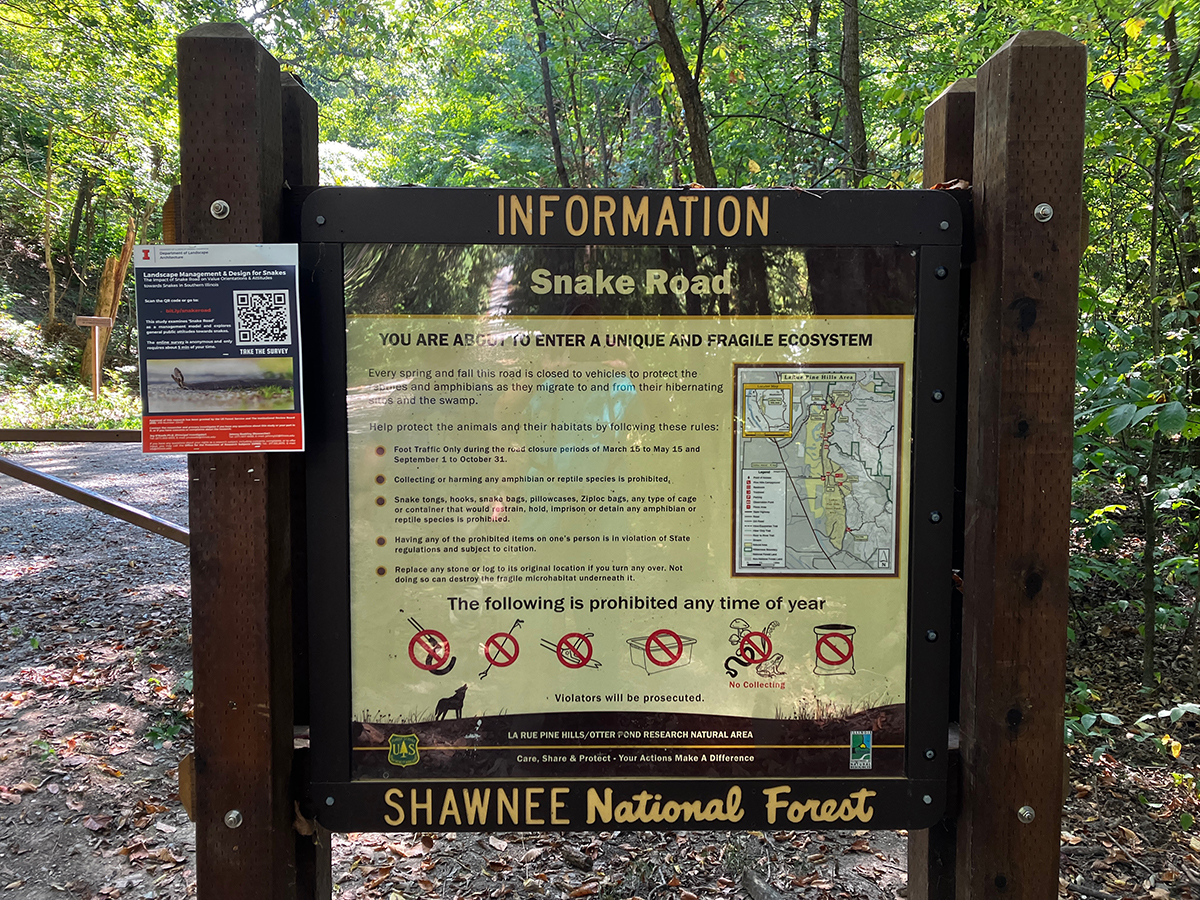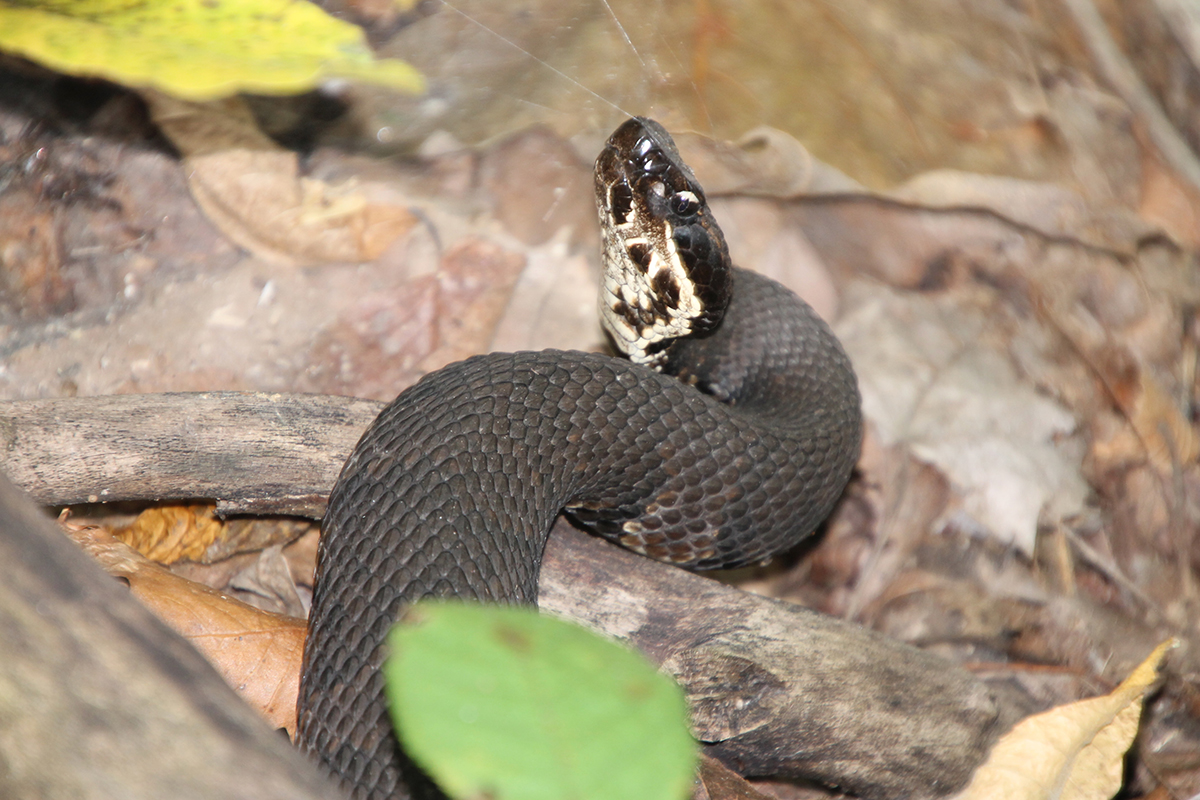A visit to the Shawnee National Forest in either the spring or fall has become an annual ritual for me over the years. Wildflowers in the spring and colorful foliage in the fall are obvious attractions, but there is an additional draw that is unique to the region: Snake migration. A gravel road that runs through a section of National Forest in Union County is uniquely situated. It runs parallel to the rocky cliffs overlooking the wetlands along the Big Muddy River. The bluffs provide excellent winter hibernation sites, while the wetlands offer ample summer hunting areas for many species of snakes. So many reptiles cross the road on their seasonal trek during this migration that the roadway is closed to vehicular traffic in the spring and fall. Officially known as Forest Road 345 or LaRue Road, it is better known as Snake Road. It is located on the western side of the LaRue-Pine Hills natural area.
 An abundance of serpents wouldn’t likely be part of any ecotourism marketing plan. For whatever reason, snakes elicit more anxiety than just about any other animal. However, the USFS has created parking areas on the north end of the road, just before heavy gates that block traffic. During snake migration these lots are full, and the roadway becomes a wide path for reptile enthusiasts. If it is a warm sunny day, you are almost guaranteed to see several species of snakes. Don’t expect it to be a slithering carpet of serpents though. If you are lucky, you may see a dozen snakes on a two-mile walk. This region of Illinois is one of the most ecologically diverse areas of the state with several different habitats and ecoregions converging in one location. So, the diversity of reptiles is also rich, and 26 species of snakes can be found here.
An abundance of serpents wouldn’t likely be part of any ecotourism marketing plan. For whatever reason, snakes elicit more anxiety than just about any other animal. However, the USFS has created parking areas on the north end of the road, just before heavy gates that block traffic. During snake migration these lots are full, and the roadway becomes a wide path for reptile enthusiasts. If it is a warm sunny day, you are almost guaranteed to see several species of snakes. Don’t expect it to be a slithering carpet of serpents though. If you are lucky, you may see a dozen snakes on a two-mile walk. This region of Illinois is one of the most ecologically diverse areas of the state with several different habitats and ecoregions converging in one location. So, the diversity of reptiles is also rich, and 26 species of snakes can be found here.

Cottonmouth (Agkistrodon piscivorus) along Snake Road in mid-October 2023 at Shawnee National Forest.
You can’t mention snakes without addressing the fact that some are venomous. Along Snake Road, it is possible to find three species of venomous snakes; Copperhead (Agkistrodon contortrix), Cottonmouth or Water Moccasin (Agkistrodon piscivorus), and Timber Rattlesnake (Crotalus horridus). Of the three, the Cottonmouth is the most likely venomous snake you will see along the road. They are secretive and shy, so you really have to be observant to find one. During peak migration times, there are often volunteers monitoring snake species and educating visitors, so make sure to gain some experience from them.
Snakes can be challenging to identify. There is a lot of variation in color and patterns within species. Also, the color or patterning of young snakes usually look much different than adults. Thanks to our digital society, there are numerous ways of educating yourself about snakes. One of the better social media resources for the Facebook crowd is a public group called “Illinois Snake Identification and Education.” The administrators of the group do a good job in identifying snake photos that the public posts. They also moderate the discussion to be productive and fact-based. I am amazed at the amount of misinformation concerning snakes that exists in the public.
One of the most photographed and posted species of snakes on the Facebook group is the Northern Watersnake (Nerodia sipedon). This nonvenomous snake is found throughout Illinois and is common on creeks, rivers and ponds. It is a skilled swimmer and is most often mistaken for the venomous Cottonmouth (or Water Moccasin).
Here’s a little myth-busting fact for you: The venomous Cottonmouth is only found in six counties in the extreme southern tip of the state of Illinois. So those “water moccasins” you were deathly afraid of as a kid growing up in central Illinois were harmless Northern Watersnakes. In fact, there are no venomous snakes found in our part of the state, so feel free to take snakes off your anxiety list.


Recent Comments